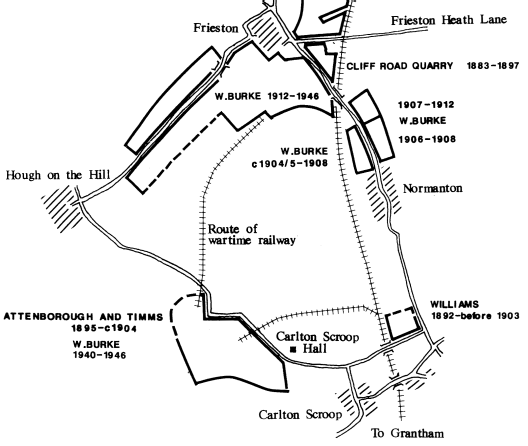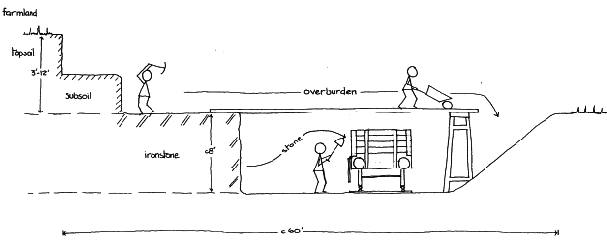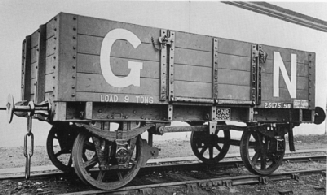

Ironstone (continued)
Methods of Working
Up to the 1930s, all work was done manually, using picks, shovels and barrows.
The main area of activity was at the exposed stone face, about eight feet high. Here, the stone was dug out with picks and loaded directly into railway wagons, a siding running parallel to the working. Explosives were used to open up the seam. Arthur Nicholson of Hough on the Hill was only about 19 when a charge went off prematurely and blinded him. ‘Blind Arthur’ returned to Hough where he earned a living by making baskets in a shed behind his cottage at Crow Park (Wildnerness Cottages).
In Dec 1916 there was a collection (by Arthur Cooling) in the Caythorpe and Hough Ironstone mines on behalf of C Nicholson, a miner who had been unable to work for 2 years due to illness. This may well have been Arthur’s father Charles. £7 was raised.
In Nov 1910 George Marston (who lived in Gelston) was working at the Normanton quarries when a large stone hit him on the head. Blasting was in progress and owing to the thick mist he didn’t see it coming and was seriously hurt. Dr Baines was summoned to the scene and ordered him to Grantham Hospital for an operation.
Ahead of the stone face the 3-12ft of overburden (topsoil and subsoil) was stripped to expose the stone. The subsoil was moved to the lower ground behind the face, with the topsoil being spread over it.
Where the necessary clearance height over the railway siding could be gained, soil and subsoil were barrowed along a walkway supported from the lower end on trestles. Behind the working area the soil would be tipped from the end of the walkway, from where it would be re-spread. The walkway was a narrow plank and great dexterity was needed to balance along it. All the workers were paid on piecework rates, so much per cubic foot, so men would travel along as fast as they could. Boys from Hough used the planks as a playground.
But it was dangerous place to play or to work. In August 1897 Thomas Jackson was wheeling a barrow along a plank when the barrow fell off, taking him with it. Nobody seems to have thought to apply a splint before sending him in a cart on a painful 8-9 mile journey to Grantham Hospital.
Loading stone into wagons must have been hard physical work. Only the top of the face could have been thrown down into wagons; as it got lower, stone had to be thrown up. As the working face moved forward, the railway siding was moved to keep pace with it. When this was needed the workforce would stop production to push the track sideways.
The length of the working face varied according to the area under lease. Because of the need to slew the track, however, it had a linear formation. Only about 5% of a leased area was taken up by the quarry at any one time. Quarrying was therefore lucrative for a landowner who could carry on farming and get royalties on the ironstone removed. This type of quarrying meant that the area was not suitable for landfill, unlike later quarrying undertaken by mechanical excavation.
The loaded wagons were gathered in the various sidings and then sorted into trains at Caythorpe station, prior to despatch to the ironworks. The GNR wagons normally carried 8.6 tons of stone.
The quarries seemed to have opened at the about same time as the 1870s slump in agriculture. In 1905 the Grantham Journal reported that ironstone men were always better paid than agricultural labourers. An ironstone labourer working 4-6 days a week could earn more than 17/ whereas an agricultural worker might only earn 10-12/ some weeks. However, it could be dangerous work, for example:
In Oct 1886 Frederick Marston of Carlton Scroop (son of James Marston of Normanton) was on a truck at Caythorpe ironstone works when he slipped. To save from falling on his head he jumped and fractured his ankle. He was taken home in a trap and a telegram was sent to Mr Mason (bonesetter) of Grantham.
In Jan 1891 William Southwood from Gelston (aged about 18) was working at Caythorpe quarries when his left leg was badly shattered through a large piece of ironstone falling on it. On arrival at Grantham Hospital it was found necessary to amputate.
In Sep 1891 William West of Main Road, Hough was working at the ironstone, knocking a nail into some wood when the nail broke and blinded him in one eye.

Sources:
The Lincoln to Grantham Line via Honington (Stewart E. Squires)
The Ironstone Quarries of the Midlands History Operation and Railways (E Tonks)
Grantham Journal
Hough on the Hill History Society
Me and the Parish of Hough on the Hill (John Keeble)
Ironstone workface at Easton [Derby Museum]
Another ironstone workface around Easton with a deeper overburden
A Victorian GNR 9 ton wagon. The plate on the right hand end reads ‘Ironstone Traffic – Caythorpe and Ardsley – Return to Caythorpe when empty’. [National Railway Museum]